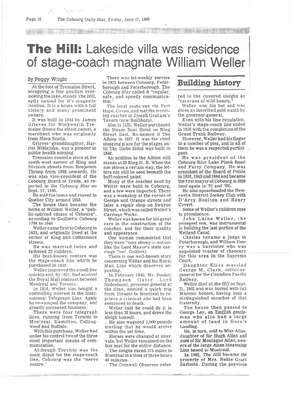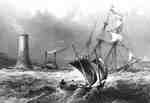The Hill: Lakeside villa was residence of stage-coach magnate William Weller
- Full Text
- The Hill: Lakeside villa was residence of stage-coach magnate William Weller
By Peggy WrightAt the foot of Tremaine Street, occupying a fine position over- looking the lake, stands The Hill, aptly named for it's magestic location. It is a house with a full history and many prominent owners.
It was built in 1844 by James Grieves for Winkworth Tre- maine (hence the street name), a merchant who was originally from Nova Scotia.
Grieves' granddaughter, Har- riet Miklejohn, was a pioneer in public health nursing.
Tremaine rented a store at the south-west corner of King and Division streets from Benjamin Throop from 1838 onwards. He was also vice-president of the Cobourg Board of Trade, as re- ported in the Cobourg Star on Sept. 17,1845.
He sold the home and moved to Quebec City around 1850. The house then became the home of William Weller, a "pub- lic-spirited citizen of Cobourg", according to Guillett's Cobourg 1798 to 1948.
Weller came first to Cobourg in 1833, and originally lived at the corner of King and Cottesmore streets.
He was married twice and fathered 22 children.
His best-known venture was the stage-coach line which he purchased in 1829.
Weller improved the small line quickly and, by 1831, had acquired the Royal Mail contract between Montreal and Toronto.
In 1834, Weller also bought a controlling interest in the Inter- national Telegraph Line. Again he re-vamped the company, and greatly increased business.
There were four telegraph lines, running from Toronto to Montreal, Hamilton, Colling- wood and Buffalo.
With this purchase, Weller had under his control two of the three most important means of com- munication.
Although Toronto was the main depot for the stage-coach line, Cobourg was the "nerve centre."
There was tri-weekly service in 1835 between Cobourg, Peter- borough and Peterborough. The Cobourg Star called it "regular, safe, and speedy communica- tion."
The local route ran via Port Hope, Cavan, and met the incom- ing coaches at Joseph Graham's Tavern (now Bailiboro).
Also in 1835, Weller purchased the Steam Boat Hotel on King Street East. Re-named it The Albion in 1837. It was the chief stopping place for the stages un- til The Globe Hotel was built in 1846.
An addition to the Albion still stands at 20 King St. E. When the sun shines a certain way, the let- ters can still be seen beneath the buff-colored paint.
Many of the coaches used by Weller were built in Cobourg, and a few were imported. There was a workshop at the corner of George and Orange streets and later a repair shop on Swayne Street, which was called Weller's Carriage Works.
Weller was known for his great care in the construction of the coaches, and for their quality and appearance.
One woman commented that they were "very showy -- not un- like the Lord Mayor's state car- riage."(ref. Guillett).
There is one well-known story concerning Weller and his Royal Mail Line which deserves re- peating.
In February 1840, Mr. Poulett Thompson (later Lord Sydenham), governor-general at the time, needed a quick trip from Toronto to Montreal to re- prieve a criminal who had been sentenced to death.
Weller said he could do it in less than 38 hours, and drove the sleigh himself.
He also wagered 1,000 pounds sterling that he would arrive within the set time.
Horses were changed at inter- vals, but Weller remained on the box seat for the entire distance. The sleighs raced 375 miles to Montreal in a time of three hours 40 minutes.
The Cornwall Observer refer- red to the covered sleighs as "caravans of wild beasts." Weller won his bet and was given an inscribed gold watch by the governor-general.
Even with his fine reputation, Weller's stage-coach line ended in 1856 with the completion of the Grand Trunk Railway.
However, Weller had his finger in a number of pies, and In all of them he was a respected partici- pant.
He was president of the Cobourg-Rice Lake Plank Road and Ferry Company. He was president of the Board of Police in 1838,1843 and 1844 and became the first mayor of Cobourg in 1850 (and again in '51 and '63).
He also spearheaded the New- castle District Jockey Club with D'Arcy Boulton and Henry Covert.
Some of Weller's children rose to prominence.
John Laine Weller, the youngest son, was instrumental in building the last portion of the Welland Canal.
Charles became a judge in Peterborough, and William Hen- ry was a barrister who was appointed master of chancery for this area in the Supreme Court.
Daughter Eliza married George M. Clark, solicitor- general for the Canadian Pacific Railway.
Weller died at the Hill on Sept. 21, 1863 and was buried with full Masonic honors, having been a distinguished member of that fraternity.
The house then passed to George Ley, an English gentle- man who also had a large amount of land in Gore's Landing.
He, in turn, sold to Miss Allan, daughter of Sir Hugh Allan and aunt of Sir Montague Allan, own- ers of the large Allan Steamsiup Line based in Montreal.
In 1902, The Hill became the property of Mrs. Nellie Grant Sartoris. During the previous year, she had rented a grand summer home on King St. E., called Heathcote.
Sartoris was the daughter of Ulysses S. Grant, President of the United Slates from 1869-77. She was married to Algernon Sartoris, an English gentleman from a family of large landown- ers in England.
They re-named the residence Claremont. The family used it as a summer home for about 20 years.
They built a huge addition on the east side, which contained a ballroom, and also constructed a small stucco house, which still stands, close to the road.
The family were part of that wealthy circle who came to Cobourg for the high social life and exceptionally clean air. There was once a belief that the local atmosphere contained high levels of health-giving ozone.
There were three children. In 1902, daughter Vivian was given one of the grandest weddings Cobourg has ever seen.
The wedding register was crammed with names of high society who had travelled from all parts of the United States to attend.
Vivian married Frank Roosevelt Scovel. Scovel's mother, Marsha, was a first cousin to Theodore Roosevelt, president of the United States from 1901-09.
He was also a nephew of Madame Albertini (nee Scovel), a famous opera singer who lived at Interlaken. Now demolished, her house used to stand on the south side of King Street, just east of Walton Street.
In 1921, the Sisters of St. Joseph from Peterborough bought The Hill.
Re-named the St. Joseph Orphanage for Girls, it served as a residence for homeless girls from across Ontario.
One of the first girls to enter the house described it as "walk- ing into a perfect castle which had been left untouched for years."
This first group were given a grand tour of all 28 rooms. They saw General Grant's carved iv- ory table and mahogany bed.
The house contained all the furniture left by the Sartoris family. There were eight huge fireplaces, and each bedroom contained a floor-length mirror. The ballroom contained one enormous mirror, which gave a wonderful reflection of the lake.
The latter was converted into a chapel by the sisters.
The orphanage was nearly self-sufficient, with a large vegetable garden, two Holstein cows and a hen-house.
In 1945, the orphanage closed, and the property became Villa St. Joseph.
It was used as a convent and summer home by the sisters for a number of years, but also fell into a state of disrepair.
The property was restored in 1972 and now functions as a re- treat.
The house occupies a serene position overlooking the lake, the double verandahs a reminder of it's life as a summer residence.
Surrounded by tall trees, lilac bushes, and a grand expanse of lawn, it remains slightly re- moved from town life.
The gothic detail and Georgian form are well kept. It is a fine example of a regency villa.
The Cobourg Daily Star would like to acknowledge the assist- ance of historian Rob Mikel with some of the information con- tained in this article.
- Media Type
- Text
- Item Type
- Clippings
- Description
- The Hill: Lakeside villa was residence of stage-coach magnate William Weller
Source: The Cobourg Daily Star, Friday, June 17, 1998
Acquired: February 2008 - Date of Publication
- 17 Jun 1988
- Subject(s)
- Local identifier
- Weller-Family-08-4
- Language of Item
- English
- Geographic Coverage
-
-
Ontario, Canada
Latitude: 43.95977 Longitude: -78.16515
-
- Copyright Statement
- Copyright status unknown. Responsibility for determining the copyright status and any use rests exclusively with the user.
- Contact
- Cobourg Public LibraryEmail:info@cobourg.library.on.ca
Website:
Agency street/mail address:200 Ontario Street, Cobourg, ON K9A 5P4



